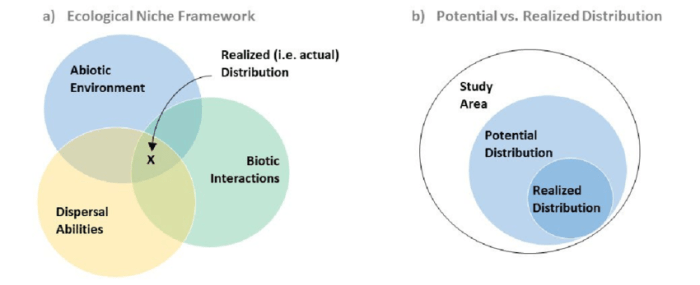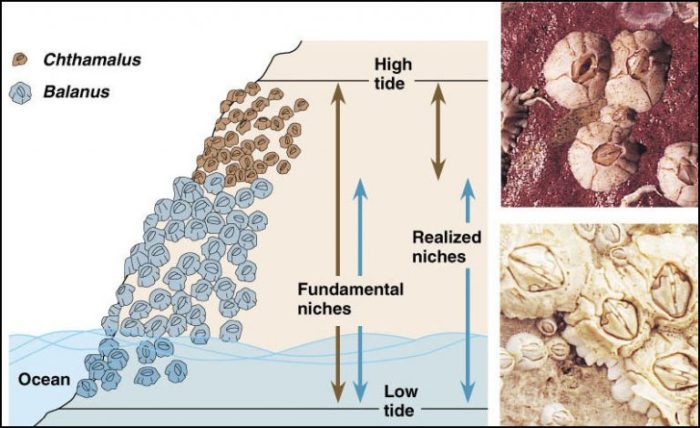The realized niche of an organism is a captivating concept that unveils the intricate interplay between an organism and its environment. It paints a vivid picture of the ecological space occupied by a species, shaped by the complex forces of competition, predation, and resource availability.
This article delves into the fascinating world of realized niches, exploring their definition, influencing factors, and ecological significance, providing a comprehensive understanding of this fundamental ecological concept.
As we embark on this journey, we will uncover the nuances that differentiate the realized niche from the fundamental niche, examining the abiotic and biotic factors that mold an organism’s ecological niche. We will delve into the methods used to measure and quantify realized niches, exploring statistical techniques and niche modeling tools.
Furthermore, we will shed light on the ecological significance of realized niches, unraveling their influence on the distribution and abundance of organisms, as well as their role in community assembly and ecosystem dynamics.
Definition of Realized Niche

The realized niche of an organism refers to the subset of its fundamental niche that it actually occupies in the presence of competition and other environmental constraints. It is the result of the interplay between the organism’s adaptations and the biotic and abiotic factors of its environment.
The realized niche differs from the fundamental niche, which represents the full range of conditions that an organism could potentially occupy in the absence of competition and other limiting factors. In reality, organisms are rarely able to fully occupy their fundamental niche due to the presence of competitors and other environmental challenges.
Factors Influencing Realized Niche
Several factors influence the realized niche of an organism, including:
- Competition:Competition with other organisms for resources, such as food, shelter, and mates, can limit the niche that an organism can occupy.
- Predation:The presence of predators can force organisms to occupy less desirable habitats or adopt defensive strategies that reduce their ability to fully utilize their fundamental niche.
- Environmental constraints:Abiotic factors, such as temperature, water availability, and habitat structure, can also limit the niche that an organism can occupy.
Factors Influencing Realized Niche

An organism’s realized niche is shaped by both abiotic and biotic factors within its environment. Abiotic factors, such as temperature, water availability, and light intensity, directly affect an organism’s survival and reproductive success. Biotic factors, such as competition, predation, and resource availability, influence the interactions between organisms and their environment, further shaping their realized niche.
Competition
Competition occurs when organisms utilize the same limited resources, such as food, water, or shelter. This competition can lead to niche partitioning, where different species occupy distinct niches within the same habitat to reduce competition and increase resource availability. For instance, in a forest ecosystem, different bird species may specialize in feeding at different heights in the canopy to avoid competition for food.
Predation
Predation is another important biotic factor that influences realized niche. The presence of predators can alter the behavior, habitat selection, and resource use of prey species. For example, in a predator-prey system, prey species may avoid areas with high predator activity, leading to a shift in their realized niche.
Resource Availability
The availability of resources, such as food, water, and shelter, can significantly impact an organism’s realized niche. When resources are abundant, organisms may have a wider realized niche, as they have access to a greater range of resources. Conversely, when resources are scarce, organisms may have a narrower realized niche, as they are limited to the resources that are available.
Ecological Significance of Realized Niche

The realized niche profoundly influences the distribution and abundance of organisms within ecosystems. It serves as a crucial factor in determining which species can coexist in a given environment and how they interact with each other.
The realized niche influences the distribution of organisms by limiting their presence to areas where they can access the resources they need and tolerate the environmental conditions. For example, a bird species that requires specific food sources and nesting sites will only be found in habitats that provide these resources.
Role in Community Assembly and Ecosystem Dynamics, The realized niche of an organism is
The realized niche plays a pivotal role in community assembly and ecosystem dynamics. By shaping the distribution and abundance of species, it influences the interactions between species, including competition, predation, and mutualism. These interactions, in turn, determine the structure and functioning of ecological communities.
For instance, in a forest ecosystem, the realized niche of a tree species may overlap with that of another species, leading to competition for resources. This competition can affect the growth, survival, and reproductive success of both species, shaping the composition and diversity of the forest community.
Applications in Conservation and Management: The Realized Niche Of An Organism Is
Understanding realized niches plays a pivotal role in informing conservation and management strategies. It provides insights into the specific conditions and resources that a species requires to thrive, allowing for targeted interventions to protect and enhance their habitats.
Predicting Impacts of Environmental Change
Knowledge of realized niches is crucial for predicting the potential impacts of environmental change on species. By identifying the environmental factors that limit a species’ distribution and abundance, researchers can assess how changes in these factors, such as temperature, precipitation, or habitat availability, might affect their realized niches.
This information can inform conservation efforts by prioritizing species and ecosystems that are most vulnerable to environmental change.
Popular Questions
What is the difference between the realized niche and the fundamental niche?
The fundamental niche represents the full range of environmental conditions in which an organism can potentially survive and reproduce, while the realized niche represents the subset of the fundamental niche that is actually occupied by the organism due to interactions with other species and environmental constraints.
How does competition influence realized niches?
Competition between species for resources such as food, shelter, and mates can limit the realized niche of each species, as they may be forced to occupy a narrower range of environmental conditions to avoid competition.
What is the role of realized niches in community assembly?
Realized niches play a crucial role in community assembly by determining which species can coexist in a particular environment. Species with similar realized niches may experience intense competition, leading to the exclusion of one or more species from the community.